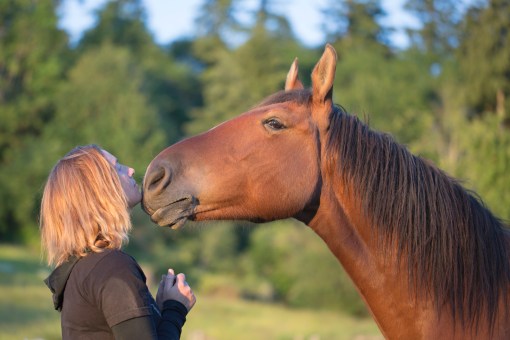The Project:
Mustangs directly off the range, One Trainer, Many Students, Communication through body language, Tools used only for safety, never to train.
The Goal:
To discover how far Equestrian Art can be developed solely using body language.
Confidence and Learned Helplessness
Yesterday I found myself sitting on an airplane on the way to a screening in New York City simply brimming with joy. My pondering, wondering mind couldn’t help but wonder why? Are emotions rational? Are emotions explainable?
I know I have a similar joy when I am able to help a horse, or a student, or a horse and student together work through the solution to a knotty problem. My pondering, wondering mind has to ask again, why is that? What even constitutes a problem in a relationship?
I truly believe it all comes down to confidence and learned helplessness. We all have things we do that are in our comfort zone, horses and people alike. These are the things we have confidence in. Somewhere in our history we learned we had a good chance at feeling OK in this situation. On the flip side, when we feel there is no hope of feeling better in a situation, this is learned helplessness. When things are too far out of our comfort zone, then our only hope becomes survival.
This confidence in a situation, the idea that a particular situation is well within our comfort zone, is simply a neural passageway in our brain that has been used often enough in such a way as to cause comfort, maybe even joy.
I believe this feeling is effective passive leadership.
Passive leadership is the ability to take personal action towards your goals in confidence, without falling into the patterns of fight, flight or freeze.
The art of applying passive leadership with a thousand-pound prey animal is more intriguing to me every day, particularly when I realize that what I learn with the horses, has a ripple effect of understanding in every situation I can imagine.
How do you simultaneously encourage horses to find their own comfort and also work with you?
How do you foster collaboration and confidence in partnership?
I named the movie Taming Wild, not because it was about taming a wild mustang. The title leads us to think more deeply about our own nature: that wild part in each of us that is willing to fight to the death for what we think we need, or run away from the things we cannot control, or even freeze and admit defeat when we have no other options. This is not just a horse problem; this is a problem with being alive that we all face together.
Is it possible to maintain our individuality in any relationship and also foster collaboration? Or does someone always have to lose out and give up some part of themselves in order to fit the relationship at hand?
That is what Taming Wild is about. Are any of us willing to tame the wild impulses of fight, flight or freeze, or do we think we need them for survival?
The answer is both. We do need them for survival, and also, we don’t collaborate well with others when we are in survival mode. The taming of those instincts is what has to happen first in order to collaborate well.
When a horse is expressing fight, flight or freeze, they are in survival mode and doing the reactionary thing they think they need to do in order to survive. This survival mode is, I believe, simply a lack of confidence in their own passive leadership.
How do we teach passive leadership in horses? How do we teach this concept of taking personal action toward a goal without fight, flight or freeze?
We lead by example.
Do you know how to work in relationship toward a goal without fighting, running away, or freezing and giving up some of yourself in order to capitulate?
Some situations are easier than others for sure. The challenge I am laying out for the world is this. Be conscious, be aware, and notice when anyone in a partnership is falling into reactionary behavior and lack of confidence.
When your horse fights with you, can you take personal action toward your goal of being in partnership – without fighting back, or running away, or giving up?
When your horse tries to run from you, can you take personal action toward a goal, without reacting to him in a survival sort of way?
And most importantly, when your horse has learned helplessness –freeze as a day to day survival skill – and no longer takes any action towards feeling better, can you still take personal action toward your goal of being in partnership without taking advantage of the helplessness in front of you?
We teach by example and our partners in any endeavor become products of their environment.
We can only truly work together when someone steps up to make the environment one of collaboration and confidence.
Be that person, and watch your horse in turn become that horse.
We are all in this together,
Hooves and Heartbeats,
Elsa























































